Working from home with headsets presents many new challenges that are very different from a traditional office environment. With babies crying, kids playing and dogs barking in the background, business calls need to be maintained in a professional matter no matter the background noise and distractions. As more of our workforce heads home to work, with many possibly staying home permanently, the following guide will help you find the perfect headset for your new home office. As headsets have become more hi-tech than you ever imagined, understanding the in’s and out’s will help you determine the perfect product to meet your needs when working from home.

Topics to be covered:
- Corded vs. Wireless
- Cost Considerations
- Wireless Range
- Wearing Options
- Noise Cancelling (Microphones & Speakers)
- Connection Types
- Headset Comfort
1) Corded vs. Wireless
This is a budget consideration. If you can afford it, you will be more productive and much happier with a wireless headset, which allows you to roam your environment and multitask while on calls. Most wireless users will receive call alerts in their headset for incoming calls which allows you to answer calls remotely with a push of a button on the headset. Wireless technology has advanced audio quality to the point your callers won’t be able to tell if you’re on a wireless or corded headset. Most styles and features will be equally available in corded and wireless headsets.
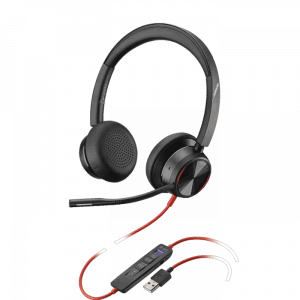
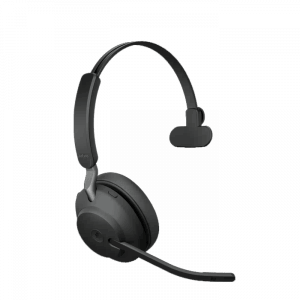
2) Cost Considerations
When considering headsets for home users, you will need to consider your budget and balance it with features and expectations.
$30-50 corded headsets are very low-end with basic features. You will typically find foam cushions, little to no padding on the headband and below average audio quality. Be prepared to spend more time sending the product back and forth for warranty replacements than you actually use the product.
$50-170 corded headsets will be a huge jump in durability, performance and comfort. Leatherette cushions and padded headbands will make for comfortable all-day wearing. You will now start seeing features that significantly improve noise canceling of the microphone and speakers (see Section 5/Speakers below).
High-end technology comes at a cost:
$150-300 wireless headsets will provide you freedom to roam making you more productive, durability to last for years, long lasting and swappable batteries for extended talk-time, and comfort for all-day wearing. You will also have styles to meet your specific needs. For example, some users will prefer light-weight and low-profile models. Others may find larger, dual speakers that go around/cover your ear more appealing for stunning sound quality. Specific noise canceling technology may be the priority for users in loud environments with kids playing, babies crying and dogs barking to help them focus and have callers not hear background noise.
Therefore, if you need headsets for users working at home that will be busy on calls, with minimized down time, product breakage, time with IT troubleshooting, and user frustration, spending a little more for quality headsets will pay huge dividends in user satisfaction and uptime.
3) Wireless Range
If you choose wireless, you will need to consider how much range you need and understand what devices are being used to calculate that distance. Examples:
A) Wireless headsets with a dock/charging base will sit on your desk, and connect to a USB port (PC or newer deskphone) via a USB cord. With this, the range is determined from the dock/charging base to the headset.

B) Wireless headsets that come with a USB dongle (a part that looks like a small thumb drive) and connect to your USB port (PC or newer deskphone), the range of this option is between the dongle and your headset. For laptop users, this means you can setup your laptop anywhere and determine the distance you need from that point to your headset.
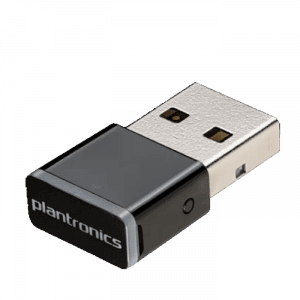
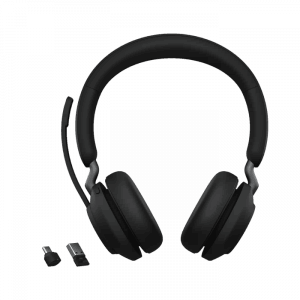

C) Wireless headsets that connect via Bluetooth will pair directly to your PC, deskphone or mobile device and your distance is simply between your headset and the device. For distance purposes, if using a laptop or mobile device, you will calculate the distance between the two, which can change constantly, depending if you leave your mobile device on a desk or always carry it with you. Most of these headset options will also include a dongle for added connectivity options.
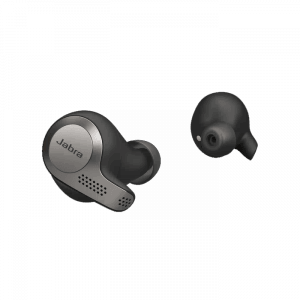
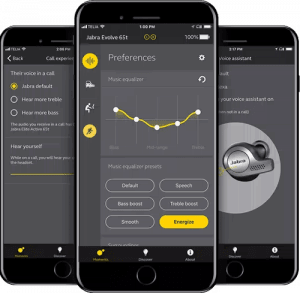
D) Original Bluetooth headset technology would give you 33 feet of range. Newer versions of Bluetooth have been developed to provide 100-300 feet of range. The more preferred business wireless technology is DECT, which gives you 300-500 feet of range. With the long ranges, you will need to research if your software/hardware allows for remote call alerts and remote answering. ‘Call control’ is the term that allows you to answer calls remotely when you press a button on your headset. When you’re hundreds of feet away from your desk, you need ‘Call control’ or you will miss most of your calls as you try and run back to your PC or other device. Free downloads available at: Poly and Jabra.
4) Wearing Options
When choosing a headset, you must first find what’s compatible with your application and needs. The next most important factor is how you want the headset to fit. Ear models are light-weight and low profile. Audio quality is above average among business grade options. Choosing a headband style with one ear cushion gives users improved audio quality, longer talk times and better stability. With a single ear headset, you have one ear open to your environment for those that need to interact with others and keep tabs on what’s going on around them.
In other words, when you choose a headband that covers both ears, your opting for complete concentration and focus. Therefore, covering both ears removes you from distractions and gives you the best possible audio quality. This will help you take precise information from your caller and rarely have the need to ask for information to be repeated. With binaural headsets being used at home, you get the best audio and longest talk times.
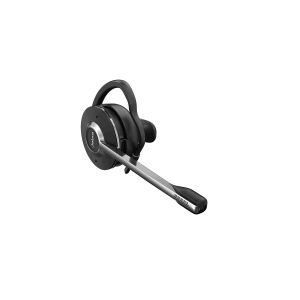
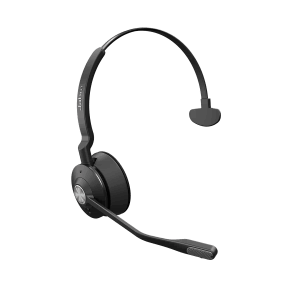
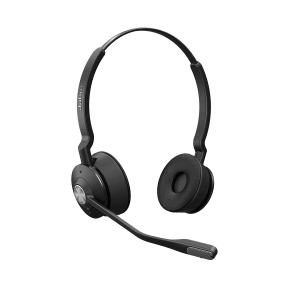
Those that are new to headsets may want to consider a convertible headset, which comes with multiple wearing options. This allows you to change between options to find your most comfortable fit. You will sacrifice a small amount of audio quality and wireless talk-time, but the trade-off is negligible for first time users.
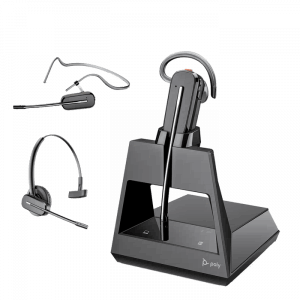
5) Noise-Cancelling: Microphones vs. Speakers (Passive, Active and Hybrid)
In a traditional environment, we’re familiar with offices, cubicles and conference rooms. When working from home you have babies crying and dogs barking, to name a few of the unique background sounds that you would prefer your callers not to hear. It’s helpful to shield yourself from background noise, which allows you to focus on your caller.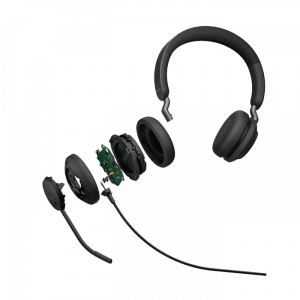
Microphones:
A) Noise-Cancelling Microphones are standard in most business grade corded and wireless headsets. The manufacturers state that up to 75% of your background noise will be reduced to help your caller hear you more clearly. However, working from home with babies crying and dogs barking is so unique that even when reduced by 75%, your caller will still be able to conclude you are working from home.
To make a difference with babies crying, dogs barking, and other extremely loud and distracting noises you will need to consider specialized technology, like Acoustic Fence by Poly to ensure your callers hear you clearly and not what’s going on around you.
Speakers:
B) Noise-Cancelling Speakers help you, the users of a headset, hear better in loud environments and avoid background noise and distractions.
Passive noise-reduction relates to how the headset is physically constructed. The larger the speaker/cushions and materials used, the greater the barrier. This separates noise around you from what you’re trying to hear through the headset (your caller).
Active noise-cancelling typically has internal microphones listening for background noise. It electronically generates a reverse sound wave that is transmitted into your speaker to eliminate or cancel out the background noise. This technology does great with low, harmonic sounds like jet engines, fans or HVAC units with a constant hum. They tend to struggle with loud, irregular office type noise and higher frequencies.
Similarly, hybrid noise-cancelling typically starts with the above active noise-cancelling. Then they add external microphones for a better understanding of the noise you’re trying to eliminate. This technology handles office noise much better, as well as, higher frequencies. The drawback is that it may generate more ‘white noise’ in your speaker, lessening your sound quality. Many newer working from home headsets will have adjustable levels of hybrid noise-canceling allowing you to find the best compromise of sound quality versus background noise-cancelling.
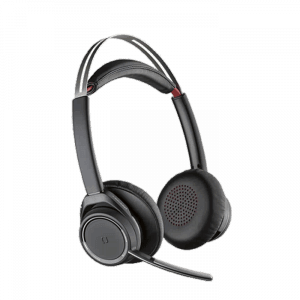
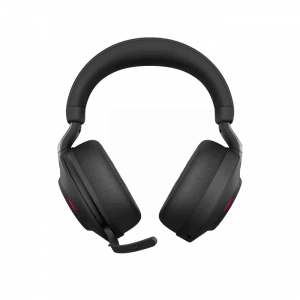
6) Connection Types:
When connecting to PC’s and newer IP phones, most devices will use a USB port. Many newer PC’s, specifically Apple MacBook laptops, have gone to a new USB-C connection for headsets. Therefore, the new port accommodates extremely thin laptops, and will be be the standard going forward.
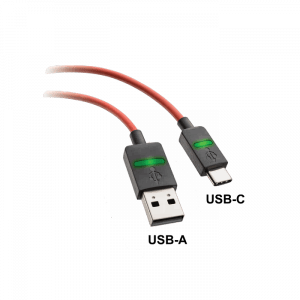
As you decide on headsets for home, make sure you know what your device will support. It will take a few years for the new USB-C to become the standard. It’s best to plan now for the future. Adapters exist for those needing a short term fix. However, it’s best to avoid adapters for long term use. It’s one more cable to account for and adds to issues with more connection points.
7) Headset Wearing Options for Home:
Above all, headset wearing options are always in the eyes of the beholder. Some like headsets that are light-weight. Others want large dual ear speakers for wifi music at the highest level. Your environment also factors in. You may need working from home headsets for use in the living room with kids, spouses and dogs coming and going. Some will like a headset covering one ear, keeping the other ear open to talk to everyone and keep the chaos under control. Others will want complete focus and cover both ears to remove background noise and distractions while working and on calls. You will also need to consider if you want ear buds, over-the-ear, or headband models. In other words, they all fit and feel very different.
Last, you need to consider comfort. If you’re an occasional headset wearer, you can most likely get by with anything. If spending more than an hour a day on calls, webinars or listening to music, you will need to expand the budget. Be sure to find a headset that is engineered with padded headbands and extra foam in the cushions. Or, find one designed around being very-light weight where you forget you’re wearing it. You will also find different needs when buying headsets for home for one user versus a team of 20+ users. The larger the team you sent home, the more you will want to standardize to as few models as possible. This makes it much easier to keep track of inventory and support.
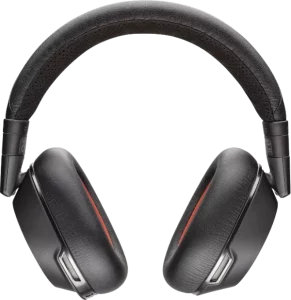
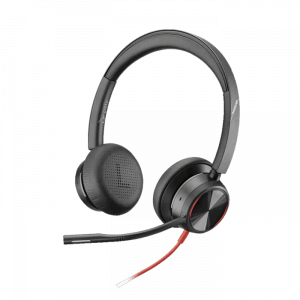
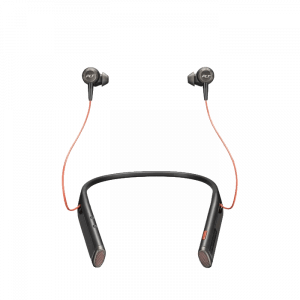
In Conclusion:
There isn’t one solution that fits all. Each of us have our own personal tastes and environments when it comes to requirements for working from home with headsets. Talk to a headset expert to narrow your choices and find your best solution. The above should help you make an educated buying decision. When working from home you want to avoid headset headaches, wasted time and shipping returns.
